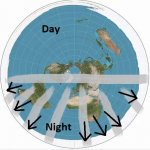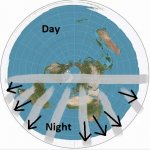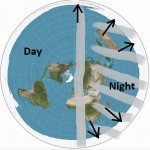To all of you non flat earthers.
- Thread starter Gina777
- Start date
-
Christian Chat is a moderated online Christian community allowing Christians around the world to fellowship with each other in real time chat via webcam, voice, and text, with the Christian Chat app. You can also start or participate in a Bible-based discussion here in the Christian Chat Forums, where members can also share with each other their own videos, pictures, or favorite Christian music.
If you are a Christian and need encouragement and fellowship, we're here for you! If you are not a Christian but interested in knowing more about Jesus our Lord, you're also welcome! Want to know what the Bible says, and how you can apply it to your life? Join us!
To make new Christian friends now around the world, click here to join Christian Chat.
And so... After months of study of the southern cross sky through observation and documentation...
I hereby denounce this particular flat earth model and any earth model that fails to identify one north pole and one south pole
I hereby denounce this particular flat earth model and any earth model that fails to identify one north pole and one south pole
M
Gina777 isn't playing. Meaning, we got played.
-
2
- Show all
Is it really a flat earth model you denounce, or an astronomy model? To my understanding, you haven't yet demonstrated that water has curvature.
My observations of the stars only affirm one fact...
The south pole exists...
The FE explanation doesn't account for the crux/south being in multiple places at once.
Its filled with misinformation about our skies going as far as to even suggest that the southern cross doesn't exist along with other southern constellations...
U finally put up an avatar... LoL... Nice
@Moses_Young
You joined the conversation late. My only question to Gary and yourself was...
How can we be facing south at the southern cross simultaneously???
And he gave me the same misconceptions as you did...

Thats the only thing im focusing on.. South. The southern cross/crux..
It cannot physically be in more than one position
Simply put...
One crux
One south
You joined the conversation late. My only question to Gary and yourself was...
How can we be facing south at the southern cross simultaneously???
And he gave me the same misconceptions as you did...

Thats the only thing im focusing on.. South. The southern cross/crux..
It cannot physically be in more than one position
Simply put...
One crux
One south
Thats what makes the FE model impossible... It can't be in multiple positions at once
The cross can be viewed from anywhere in the south just like Polaris in the north...
From multiple positions at once
As long as there is no cloud and no sun.
So half of the world at once
Applies to both
There is no "mysteries of the heavenly bodies"...
If your facing crux your facing south... One south pole
If your facing dipper your facing north... One north pole
Their simple facts... No mystery about that
The cross can be viewed from anywhere in the south just like Polaris in the north...
From multiple positions at once
As long as there is no cloud and no sun.
So half of the world at once
Applies to both
There is no "mysteries of the heavenly bodies"...
If your facing crux your facing south... One south pole
If your facing dipper your facing north... One north pole
Their simple facts... No mystery about that
Are you saying the southern cross is stationary? Stationary would be the only way to get different angles only. There are only 3 continents with an alleged view of the stationary position. The issue would be the size of Antarctica and does the southern cross rise and set there.
Just like the dipper isn't stationary.
Another horrible FE misconception
The alleged southern cross...  Ok time to fess up
Ok time to fess up
There is no southern cross... It doesn't exist... Its a phantom constellation...
I've been employed by NASA to keep the lie going...
Me along with hundreds of millions of people in the southern hemisphere... We're all double agents...
The southern cross was invented to develop globe earth theory in the first place
Ye true. The crux is not stationary in the FE model
GE says that the stars are stationary and that the earth moves...
Im not arguing either way.
Im just asserting the fact that there is one crux and one south
There is no southern cross... It doesn't exist... Its a phantom constellation...
I've been employed by NASA to keep the lie going...
Me along with hundreds of millions of people in the southern hemisphere... We're all double agents...
The southern cross was invented to develop globe earth theory in the first place
That is your horrible misconception concerning FE.
FE does not say that.
FE says the earth is stationary.
FE says the stars are moving.
FE does not say that.
FE says the earth is stationary.
FE says the stars are moving.
GE says that the stars are stationary and that the earth moves...
Im not arguing either way.
Im just asserting the fact that there is one crux and one south
Are you saying the southern cross is stationary?
Im not particularly arguing either way, just that there is one southern cross that always points to one south on the compass.
BE theory says the starts are stationary. From that perspective the crux is stationary
FE theory says the earth is stationary. From that perspective the crux is moving
Stationary would be the only way to get different angles
only. There are only 3 continents with an alleged view of the stationary position.
And there are four continents with the alleged view of the north star
The issue would be the size of Antarctica and does the southern cross rise and set there.
From what i read, its the same in Antarctica, it doesn't rise or fall either.
And its always pointing south
Ok maybe i misunderstood...
Im not particularly arguing either way, just that there is one southern cross that always points to one south on the compass.
BE theory says the starts are stationary. From that perspective the crux is stationary
FE theory says the earth is stationary. From that perspective the crux is moving
Ye i think i know what u mean
Well there is Southern Africa, South America, Southern Australasia and Antarctica... Four
And there are four continents with the alleged view of the north star
Where i am, in Australia, the crux doesn't ever rise or fall, its always in the sky, all year round, same as Africa and Sth America...
From what i read, its the same in Antarctica, it doesn't rise or fall either.
And its always pointing south
Im not particularly arguing either way, just that there is one southern cross that always points to one south on the compass.
BE theory says the starts are stationary. From that perspective the crux is stationary
FE theory says the earth is stationary. From that perspective the crux is moving
Ye i think i know what u mean
Well there is Southern Africa, South America, Southern Australasia and Antarctica... Four
And there are four continents with the alleged view of the north star
Where i am, in Australia, the crux doesn't ever rise or fall, its always in the sky, all year round, same as Africa and Sth America...
From what i read, its the same in Antarctica, it doesn't rise or fall either.
And its always pointing south
If one were to go with small and moving, like Australia, the SC would look the same in Antarctica. If Antarctica is the four corners, then the SC would have the same view (orbital course) at night opposite the sun during the day, as the sun. Meaning the SC would literally not even be above a spot during the day, like the sun is literally not "above" that spot at night. It would definitely not be stationary. It would literally make the largest orbit around the northern star, while the northern star would have a very small orbit at the center of the map.
So to refute, during the darker winter, the SC would always be in the "same spot" 24 hours a day. It would seem stationary because it would be part of the "universe" and not part of the firmament above the earth. Even in Canada during the summer the sun looks like it is further north than it literally is. Even on the earth perspective can be decieving as to the actual position above the earth. That is not because of either curvature or being flat.
It would seem to me that the stars change the size of their orbit path in accordance with the change of the sun's. They are not on one fixed course. The SC would "move across the sky" slighy faster than the sun does. It would also move faster in the winter time (northern hemisphere) than in the summer. That is why those in Texas only have a small window of time to daily view the SC in certain seasons.
One other point about a globe is time variance. The closer one gets to "both poles" the distance in longitude becomes smaller. For time to be equal the area near the poles would have to spin slower than the equator. This effect in reality is somewhat negated by either constant light or constant dark. Except time does not change differently as if the earth is not spinning. The fact that there is more light in summer and more dark in winter just means the sun has changed to a wider orbit, and still moves at the same speed regardless. The equal day is still the same at the equator even though the orbital path of the sun changes during the year.
God did declare the stars and the two lights to work as a clock. Genesis 1:14
And God said, Let there be lights in the firmament of the heaven to divide the day from the night; and let them be for signs, and for seasons, and for days, and years:
Since there is a clock in the firmament it is smaller than the earth. The widest orbit is still above Antarctica and not outside of the firmament. Of course not many people live at the ends of the earth. Not yet.
@Moses_Young
You joined the conversation late. My only question to Gary and yourself was...
How can we be facing south at the southern cross simultaneously???
And he gave me the same misconceptions as you did...
View attachment 227922
Thats the only thing im focusing on.. South. The southern cross/crux..
It cannot physically be in more than one position
Simply put...
One crux
One south
You joined the conversation late. My only question to Gary and yourself was...
How can we be facing south at the southern cross simultaneously???
And he gave me the same misconceptions as you did...
View attachment 227922
Thats the only thing im focusing on.. South. The southern cross/crux..
It cannot physically be in more than one position
Simply put...
One crux
One south
Anyway, say there are two places in the Southern Hemisphere, where two guys in the different locations (one guy at each location) are looking simultaneously at the Southern Cross, and both their compasses point South.... When you say South, is it like, exactly South, or South plus/minus a number of degrees? I can't really explain it, except for coming up with some hypothesis invoking a transparent firmament and refraction. However, I would counter with the argument that if the Southern Cross really does sit atop a pole in the South above (below?) a globe-shaped Earth, it should therefore be observable simultaneously by anyone in the Southern Hemisphere observing the night sky, at all (night) times of the year. There are claims that it cannot, therefore (if these are true) the Earth cannot be a ball.
As discussed previously, I think there is more to the workings of the Heavenly bodies than we currently understand (whether ball-Earthers or flat-Earthers), so invoking the Heavens to prove Earth's shape often ends up in a stalemate (as opposed to directly observable, measurable evidence taken here on Earth, such as laser-light over a frozen lake).
View attachment 227823
Can you see what 30 degrees looks like @GaryA ??? And what 180 degrees is???
And can you see the directions the others are facing Gazza???
So stop trying to find excuses and start repeating the mantra fact
Can you see what 30 degrees looks like @GaryA ??? And what 180 degrees is???
And can you see the directions the others are facing Gazza???
So stop trying to find excuses and start repeating the mantra fact
Degree measures on a circle may be absolute or relative. You are using them in a relative sense, but your commentary implies that it's an absolute sense.
There are at least three ways in which 30 degrees may be used in your star diagram: relative to "True South" (vertical), relative to the horizon (elevation) or relative to another observer (planar). I haven't seen that you have noted which.
In reference to this specific post, if Gary were to answer in reference to your diagram, he would correctly say that 180 degrees is directly opposite to the way in which "Me" is facing, while 30 degrees is a little to the left. However, we all understand circles well enough to know that all these concepts may be absolute or relative.
So, how about going back to your diagrams and explaining them with appropriate detail and specificity, rather than assuming or implying that others are lacking in basic understanding or intelligence.
-
1
- Show all
PC, I have followed this discussion between you and Gary, and I have to say that although I understand and agree with your position, you have not done a good job of explaining it. Your diagrams don't directly support what you are saying.
To me its simple... One southern cross... One south
I can't have a conversation with three people trying to bring up different points all at once...
Ive been through it all now with Gary.
The only fact that im asserting is that there is one south pole.
Iv tried to explain it the best i can in my previous posts with illustrations
Sorry if its hard to understand, i tried the best i could, and thats my conclusion after looking at the southern cross for over 2 months

This FE model cannot explain how we are all facing crux to the south simultaneously
It tries to by using misinformation
Ive been through it all now with Gary.
The only fact that im asserting is that there is one south pole.
Iv tried to explain it the best i can in my previous posts with illustrations
Sorry if its hard to understand, i tried the best i could, and thats my conclusion after looking at the southern cross for over 2 months

This FE model cannot explain how we are all facing crux to the south simultaneously
It tries to by using misinformation
Don't worry; the North Star refutes Gary's flat earth model as effectively as the Southern Cross.
It rotates like the dipper does around the NCP...
Have a look. The crux rotates in a clockwise direction 25-30 degrees from the SCP (the center point in the sky)
It takes 24 hours to complete a rotation

In comparison the outer edge of the dipper only lays 10-15 degrees from the NCP as it rotates counter clockwise

True?
I do try to make myself coherent. Im better with numbers than letters.
Its easy to misinterpret things on these forums as well, especially complicated stuff
But thats all irrelevant to the facts i was presenting to Garry anyway...
- If your facing southern cross then your facing south
- We can see the cross simultaneously from wherever its dark in the southern hemisphere
- Same as the dipper in the north, regardless of orientation or 30 degrees or anything
Their really simple facts that anyone can understand
So my only question to Gary and FE was;
How can we all be looking south at the southern cross simultaneously in different directions??? How???



The responses have been full of misconceptions and invalid
Sorry i didn't read you post properly first... I was just thinking "not another flat earther"...
-
1
- Show all
Is it really a flat earth model you denounce, or an astronomy model? To my understanding, you haven't yet demonstrated that water has curvature.
